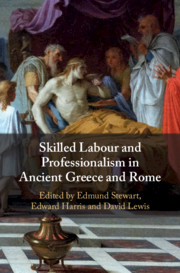Book contents
- Skilled Labour and Professionalism in Ancient Greece and Rome
- Skilled Labour and Professionalism in Ancient Greece and Rome
- Copyright page
- Contents
- Illustrations
- Contributors
- Acknowledgements
- Abbreviations
- Introduction
- Part I Professionals and Professional Identity in Greece and Rome
- 1 Many Ancient Greek Occupations, but Few Professions
- 2 Skilled Workers in the Ancient Greek City: Public Employment, Selection Methods, and Evaluation
- 3 Money Making, ‘Avarice’, and Elite Strategies of Distinction in the Roman World
- Part II Specialization and the Division of Labour in the Ancient City
- Part III Case Studies of Professions 1: Sculpture
- Part IV Case Studies of Professions 2: Music and Athletics
- Part V Case Studies of Professions 3: A Profession of Arms?
- Index
- References
1 - Many Ancient Greek Occupations, but Few Professions
from Part I - Professionals and Professional Identity in Greece and Rome
Published online by Cambridge University Press: 18 September 2020
- Skilled Labour and Professionalism in Ancient Greece and Rome
- Skilled Labour and Professionalism in Ancient Greece and Rome
- Copyright page
- Contents
- Illustrations
- Contributors
- Acknowledgements
- Abbreviations
- Introduction
- Part I Professionals and Professional Identity in Greece and Rome
- 1 Many Ancient Greek Occupations, but Few Professions
- 2 Skilled Workers in the Ancient Greek City: Public Employment, Selection Methods, and Evaluation
- 3 Money Making, ‘Avarice’, and Elite Strategies of Distinction in the Roman World
- Part II Specialization and the Division of Labour in the Ancient City
- Part III Case Studies of Professions 1: Sculpture
- Part IV Case Studies of Professions 2: Music and Athletics
- Part V Case Studies of Professions 3: A Profession of Arms?
- Index
- References
Summary
We now know that in Classical Athens there were as many as 200 occupations. This essay shows that not all occupations enjoyed an equal amount of status and prestige. Four occupations are studied: actors, especially those in the Associations of Dionysiac Artists, philosophers, doctors, and sculptors. These occupations required extensive training and acquired some features associated with modern professions.
Keywords
- Type
- Chapter
- Information
- Publisher: Cambridge University PressPrint publication year: 2020
References
- 2
- Cited by



